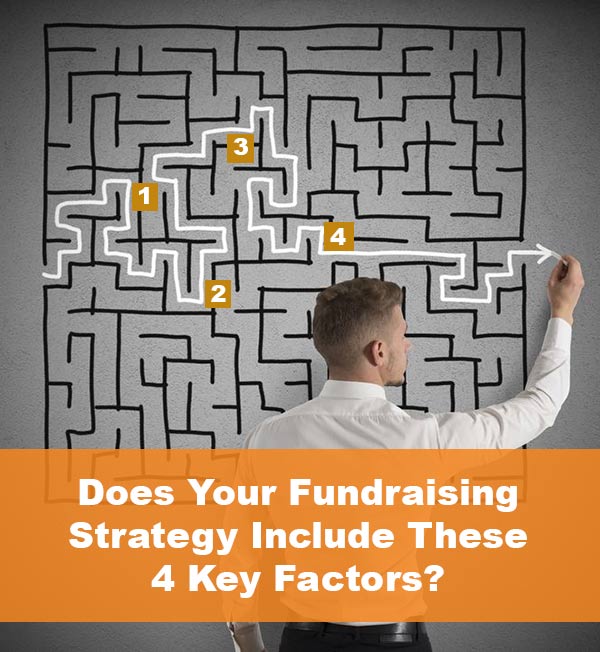Let’s take a minute to consider your fundraising strategy. Is your nonprofit struggling to meet your fundraising goals? Are you struggling to stay relevant in an increasingly digital world, or maybe wondering how to develop your donor relationships in a world that’s increasingly cluttered with communications?
You’re not alone! Each year, nonprofits need to re-evaluate their fundraising strategy to ensure they can stay ahead of the trends and relevant in a saturated landscape. We’ve collected four key factors that your team needs to keep in mind. These factors form a crucial foundation for fundraising in 2020:
1. An Understanding of Nonprofit Donation Processing
Many nonprofits are operating with a minimal understanding of nonprofit donation processing. They know that somehow gifts are translated into their organization’s merchant account, but the back-end processes that turn a credit card donation into actionable funds? That tends to be less clear.
This is understandable because donation processing can be very confusing! However, it’s essential that nonprofit leaders develop some base level understanding of the process to:
- Save money on processing fees
- Guarantee secure handling of donor financial information
- Instill confidence in supporters using digital giving methods
It’s important to iron out the basics of your online donation tool’s processing powers before investing in one. You’re unlikely to have much power to change the process after choosing a donation platform, so if you’re unhappy with how things are handled you’ll have to re-invest. That’s a headache!
Here are some of the basics to look for when choosing an online donation tool (and the payment processor it works with):
- Security. PCI-compliance is a must when it comes to handling donors’ financial information.
- Flexible options. For example, choose a fundraising software that also integrates with major payment processing aggregators such as Paypal and Stripe.
- Low operational costs. Every donation you process comes with a processing fee. Be mindful when choosing a donation tool as each one has a different payment processing rate.
Also read: Sample Fundraising Letter: Community Fund for People in Need
2. Customized Digital Collateral
Consider the following statistics, all pulled from Nonprofits Source’s Ultimate List of Charitable Giving Statistics for 2018:
- Total online giving is on the rise, steadily increasing every year (up 10.6% through April 2018).
- 54% of donors prefer to give online via credit or debit card.
- Only 67% of nonprofits are currently equipped to accept online donations.
This makes sense once you consider how much of life now takes place on the internet. We connect with friends near and far, we shop for everything under the sun, and we even pay our bills on the internet. Why wouldn’t contributing to nonprofits follow the same pattern?
If this trend continues, these statistics point to one thing— if your nonprofit and its toolkit aren’t optimized to collect gifts via online methods, you might fall behind the times. This toolkit includes:
- Your digital giving page.
- Your nonprofit’s website.
- Your social media networks.
- Your email newsletter.
First and foremost, you must have a digital giving page to accept any donations online, period. Then, the following three digital tools are used to spread the word about your online donation processes (and any fundraising initiatives you may have going on.) However, it’s not enough to simply have these resources. They must be customized to your nonprofit’s needs, as well.
Choose an online donation tool that allows for full customization of your digital giving form. For example, you want the ability to create donation forms that are fully branded to your nonprofit for a familiar giving experience.
Further, you want the ability to customize form fields, with information on recurring giving and even suggested gift amounts. (For more information about online donation tools, click here.)
The ability to collect donations online is becoming central to a nonprofit’s success and customized digital collateral is essential to doing so successfully.
3. Defined Donor Data Practices
Each donor interaction comes with a data point, whether an email response, a digital gift or even a volunteer experience. Each of these interactions should be stored in your nonprofit’s CRM, your largest donor database. However, if they’re not stored correctly things can get confusing— fast.
If your nonprofit doesn’t have clearly defined and communicated methods for the storage of donor data, your fundraising strategy is missing out. Having this data clearly organized allows your nonprofit to more easily practice prospect research and discover those with the highest giving capacity and affinity, factors that point to a donor’s likelihood to give.
Ensure your staff can easily examine these factors by making sure each donor data point is logged in your CRM in a similar manner. Create standardized processes for entering:
- Duplicate entries.
- Formal names versus nicknames.
- Salutations, such as Mr./Mrs./Miss.
- Abbreviations, such as for addresses (Street vs. St., Apartment vs. Apt.), employers (Corporation vs. Co.), etc.
- Numbers, such as phone numbers.
Create rules that are most helpful for your nonprofit’s donor data. Make sure these processes are clearly communicated to your nonprofit’s staff as they’ll do little good if no one is aware of them.
Also read: What Went Wrong: 9 Reason a Fundraising Appeal Fails
4. An Abundance of Creativity!
Experts will advise your nonprofit to invest in the latest tools and software to improve your fundraising strategy. They’ll suggest turning to new outreach methods and examining your data for more targeted communications. Those are all great strategies— after all, we’ve suggested them as well.
However, if you’re not approaching your fundraising strategy with an abundance of creativity, things might get difficult.
Donors are solicited a lot. They’re hit with a barrage of donation asks (it’s what a nonprofit has to do to survive!) and many of these asks are often similar. Online fundraising asks, peer-to-peer campaigns, walk-a-thons… these methods are all tried and true, but donors see them all the time.
It’s crucial that your donors don’t burn out from the everyday appeals. Ensure they don’t get bored by getting creative with your efforts.
For example, consider incorporating a viral video challenge into your next initiative. This is when donors complete a silly challenge on video, post it to social media, and ask a few people in their network to do the same. Each person that completes the task makes a donation via your digital giving page.
Or, if you’re working with a less tech-savvy crowd, simply consider how you can diversify the fundraising events you’re already using. Do you host an annual walk-a-thon? Consider asking for new and gently used sneakers for donation, and hosting a running shoe drive. Or, do you host an annual auction? Consider centering the event around one big-ticket item sure to impress your supporters.
Evaluate your current fundraising strategy: Are any of the above factors missing? Then you might be missing out!
Building a solid foundation is crucial to successfully fundraise in the new year, and these four facets are essential when doing so. Consider incorporating any of these factors, whether updating your digital fundraising methods or simply getting creative, heading into the new year.
——-
About the author:
Andrew Berry is the Head of Marketing and Customer Success for Donately. After getting involved with nonprofits at a young age, he discovered a passion for helping organizations that are making the world a better place. Knowing how vital online fundraising has become, his goal is to help nonprofits raise more money online each year! In his spare time, you will find him cooking up dinner, playing with his dog or cheering on Boston sports teams.


